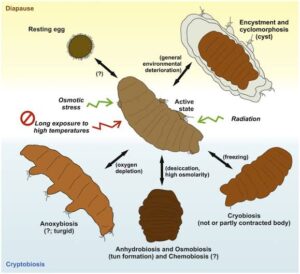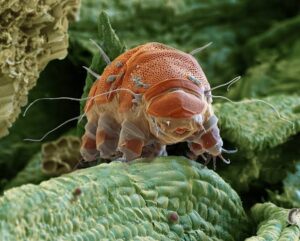Back to: ZOOLOGY 200 Level
WELCOME TO CLASS
Today’s lesson will open your eyes to an extraordinary survival strategy used by some of the tiniest animals on Earth. We’re going to look at Cryptobiosis, the fascinating world of creatures that can practically “pause” their lives! We’ll also examine their habitats and structure to understand how they thrive in some of the harshest environments imaginable.
Cryptobiosis, Habitats, Structure
Cryptobiosis
Cryptobiosis is a unique biological state in which an organism’s metabolic activities come to a near-complete halt. This remarkable process allows the organism to survive extreme conditions like dryness, freezing temperatures, lack of oxygen, or even exposure to harmful radiation.

A perfect example of cryptobiosis is found in tardigrades, also known as water bears. These microscopic animals can survive being boiled, frozen, dehydrated, or exposed to space radiation—all thanks to their ability to enter cryptobiosis. When conditions become hostile, the tardigrade retracts its limbs and loses almost all body water, forming a tiny, protective ball called a “tun”. In this state, it can remain inactive for years, even decades, until favourable conditions return.
This ability is not limited to tardigrades alone. Some nematodes (roundworms) and rotifers also exhibit cryptobiosis. It’s a truly incredible adaptation that allows life to persist against all odds.
Habitats
Despite their tiny size, cryptobiotic animals can be found almost everywhere, from mountain tops to the deep sea, and even inside mosses or lichen on trees. Tardigrades are commonly found in moist environments such as soil, freshwater, and leaf litter. Rotifers thrive in ponds and puddles, while some nematodes are found in extreme deserts and polar ice.
What makes these animals special is their ability to adapt to sudden changes in their environment. For instance, when a temporary pool dries up, rotifers can enter cryptobiosis, waiting patiently until water returns. This survival strategy enables them to live in places where most animals could not survive for long.
Structure
The body structures of cryptobiotic animals are simple but highly efficient. Tardigrades have a soft, segmented body with four pairs of stubby legs tipped with tiny claws. Despite their simplicity, they have complex internal systems for digestion, circulation, and even a rudimentary nervous system.

Rotifers have wheel-like structures called cilia around their mouths, which they use to sweep in food particles and for movement. Nematodes, with their elongated, cylindrical bodies, often have tough outer cuticles that protect them from harsh environments.
The simplicity and flexibility of their body structures allow these animals to contract into protective forms when entering cryptobiosis and return to normal when conditions improve.
Summary
- Cryptobiosis is a survival state where metabolic processes nearly stop, allowing animals like tardigrades, rotifers, and nematodes to survive extreme conditions.
- These animals are found in diverse habitats such as soil, water, mosses, and even harsh deserts or frozen regions.
- Their body structures—though simple—are designed for survival, with features like claws, cilia, and protective cuticles enabling them to enter and exit cryptobiosis effectively.
Evaluation
- What is cryptobiosis, and why is it important for survival?
- Name two animals that can undergo cryptobiosis and describe where they are commonly found.
- How does the structure of a tardigrade help it survive in harsh environments?
- Describe how rotifers use cilia in feeding and movement.
You’ve just uncovered one of the most mind-blowing survival tricks in the animal kingdom. Remember, even the smallest creatures have powerful ways to adapt. Keep learning and let Afrilearn be your guide as we continue discovering the wonders of life together!
